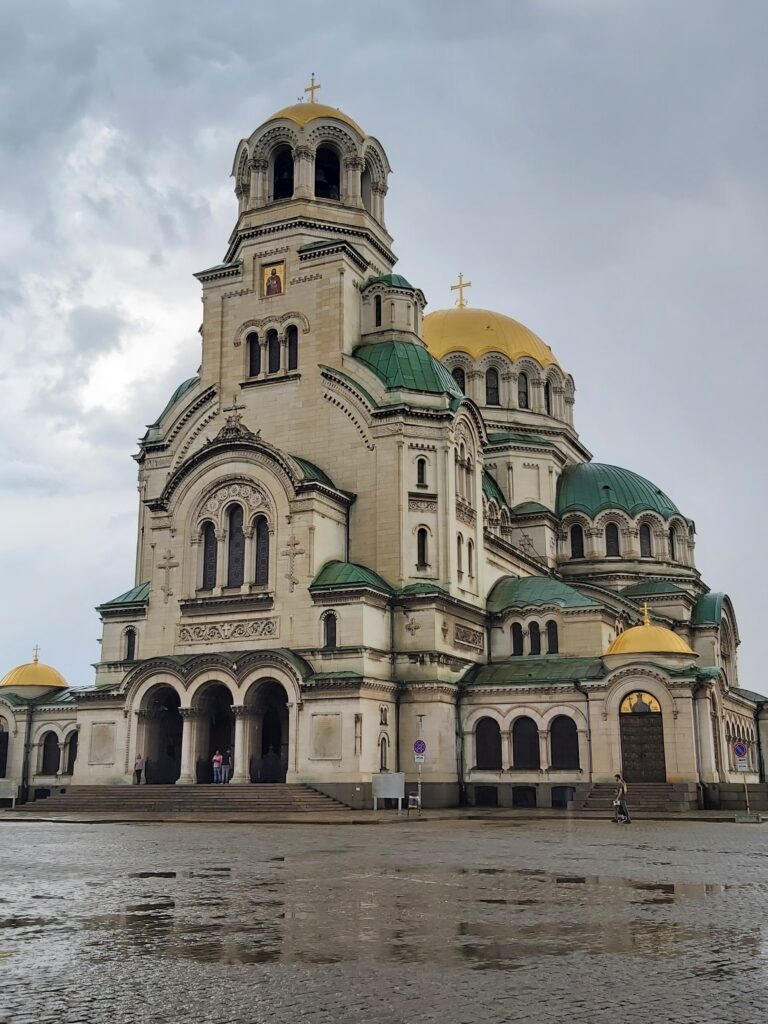Good news, Austrian Airlines loads passengers from the outside in. Window, then middle, then aisle seat. Pretty cool, but disheartening if you have an aisle seat and don’t know why you’re getting on last. Now I know, and approve.
Bad news, I spent the first 6 days in Sofia battling a cold I caught from a woman on the plane. Aviation Rule 7A: never fly with sinus congestion. At least I have the satisfaction of seeing that she couldn’t clear her ears on landing. Aviation Rule 7B: always carry a bottle of nasal decongestant spray, because we know you’ll violate Rule 7A. Too bad she didn’t have COVID, then I might have been asymptomatic.
Sofia, capital of Bulgaria, home of “it looks like Russian, but it’s really Bulgarian.” Bulgarian, like Russian, uses the Cyrillic Alphabet. Although Russian and Bulgarian look the same, the languages are from different branches of the Slavic language tree. Don’t believe the internet, Bulgarians cannot understand Russian—I did a survey, sample size of 1.
The Cyrillic alphabet was created in the 9th century in the First Bulgarian Empire by disciples of Saint Cyril and Saint Methodius, the two brothers who created the earlier Glagolitic script (Slavic script). It is a very strange alphabet, to be sure. The good news is that I already know A, E, K, M, O and T.
“It’ll be a laugh,” one monk said to the other, “not to use the letters we have, but to just make up new ones.” So, the ‘B’ is a ‘V’, and there is no ‘V’. A ‘P’ is an ‘R’; the ‘R’ is backwards and not an ‘R’ at all. Instead of a ‘Z’, just a ‘3’. What were those monks drinking? And, yes, I am certain that if I knew the whole story, it would make perfect sense. Wikipedia says, the “letter Z was borrowed from the Greek Zeta, most likely to represent the sound /t͡s/. At c. 300 BC, Appius Claudius Caecus, the Roman censor, removed the letter Z from the alphabet, allegedly due to his distaste for the letter, in that it ‘looked like the tongue of a corpse’.” Huh. Different underlying sounds, dead tongues… Never mind.

How ever it happened, it’s a good idea to learn the Cyrillic alphabet. The Cyrillic alphabet is used in Bulgaria, North Macedonia, Montenegro and Serbia, all of which I plan to visit in the next 3 months. Plus, a surprising number of words are just phonetic spellings of other words. Like, PECTOPHAT—the first word I deciphered. Remember to celebrate on May 24th – Cyrillic Alphabet day!

Sophia is actually a pretty nice place. The first thing I noticed was that people are very friendly, usually, and speak English very well, often. The city is modern, with all the shop, restaurants, and Starbucks you would expect, or it is older (depending on where you are standing), where no two adjacent paving stones pitch, roll or yaw in the same way. Even in the older parts of the city, I saw quite a lot of buildings under renovation. I was informed by a British Expat, that a nice 2 bedroom apartment, in a very nice area, would cost under $200,000. In general, prices for food, drink, and umbrellas only seem high, but they are in Bulgarian leva, with 2 leva per dollar. Prices also depend on the part of town. For example, I had a very tasty cocktail at a roof top bar overlook the golden domes of the St. Alexander Nevsky Cathedral. Around $9, which was very expensive by Sofia standards. In Barcelona it would have cost close to double that. What would it cost in downtown Seattle?

Sofia’s major tourist attraction is St. Alexander Nevsky Cathedral (built 1882-1924). It is Byzantine Revival style, Orthodox Christian cathedral. It is strange, and fascinating, and ornate, and simple, and dark. So dark in fact, that they hang chandeliers to light the space. It resembles ‘unorthodox’ (?) churches in almost no way. The design reminds me a bit of Frank Lloyd Wright’s Unity temple (1905, Chicago), where the congregation is facing each other as much as they face the alter. The designs have little nothing else in common.
The food is good, basically meat and veg. And lots of veg. A local favorite is the Shopska salad with tomato, cucumber, maybe red bell pepper, all topped with a soft, white Sirene cheese. Good and good for you. The city also has just about every kind of food—Korean, Mexican, Japanese, Russian, Turkish, Italian…even American—and prices range from ‘impossibly cheap’ to ‘that seems about right.’ The center of town has a long pedestrian mall and plenty of cafes and restaurants. Prices in the center of town are naturally not impossibly cheap.
Travel in the city is easy with plenty of busses, subways and trains all on a multi-day pass. Travel is easy, but not always obvious. Neither the Central Railway Station not the Central Bus Station will get you out of the country, though. International busses depart from a separate station.
